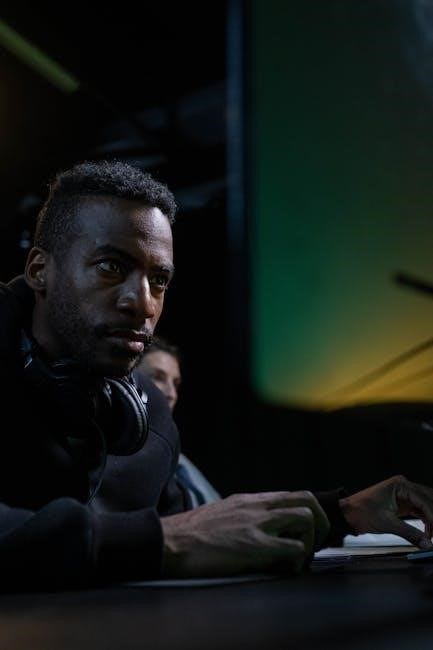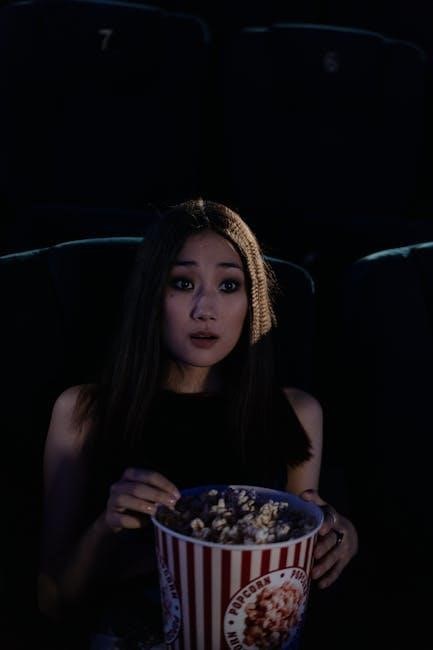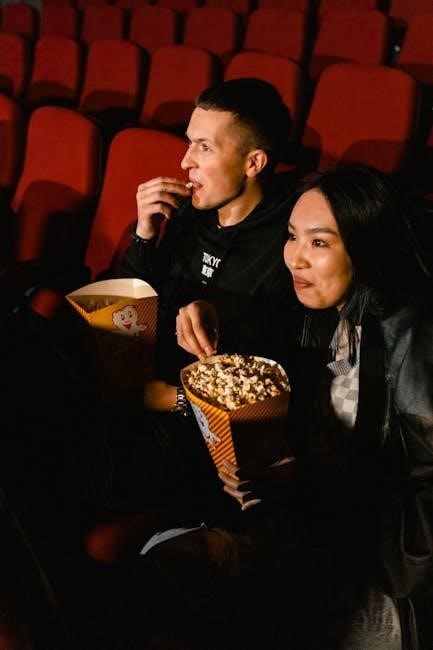Overview of the Textbook
It aims to move students beyond passive viewing and cultivate critical thinking skills regarding cinematic techniques and their effects․ The text incorporates numerous examples from classic and contemporary films‚ providing concrete illustrations of key concepts․ Furthermore‚ it emphasizes the importance of film history and the evolution of cinematic language․ Through clear explanations and engaging visuals‚ “Looking at Movies” seeks to empower students to become informed and analytical viewers‚ capable of appreciating the artistry and complexity of film․ The textbook also addresses how films are made‚ providing insight into the collaborative process of filmmaking․ This edition focuses on making movie analysis accessible and engaging․
Authors: Dave Monahan and Richard Barsam
Together‚ Monahan and Barsam have created a valuable resource for film students‚ blending theoretical rigor with practical application․ Their collaborative approach ensures that the book reflects the latest developments in film scholarship and teaching methodologies․ The authors’ dedication to student learning is evident in the textbook’s clear writing style‚ illustrative examples‚ and comprehensive coverage of key topics․ They emphasize the importance of critical analysis‚ encouraging students to move beyond passive viewing and engage with films on a deeper‚ more meaningful level․ Their work makes this textbook so valuable․
Availability of the 7th Edition PDF
Another option is to check with your university or college library‚ as they often provide access to digital textbooks through their online platforms․ Many libraries offer ebooks that can be borrowed for a specific period․ Be cautious of unofficial websites offering free PDF downloads‚ as these may infringe on copyright laws and could potentially contain malware․ Always prioritize legal and secure sources when accessing digital learning materials․ Remember that the enhanced ebook version is sometimes included with new copies of the print book․
Ebook and Print Options
The ebook often includes interactive elements‚ such as embedded videos and quizzes‚ enhancing the learning experience․ Some editions even offer an enhanced ebook version with additional media content accessible through a student website․ When deciding between the two formats‚ consider your learning style‚ budget‚ and accessibility needs․ The ebook is frequently more affordable and environmentally friendly‚ while the print version provides a classic and distraction-free reading experience․ Check if purchasing a new print copy includes access to the enhanced ebook․

Key Features of the 7th Edition
The 7th edition boasts refreshed video content‚ interactive media‚ and assessments․ These features aim to enhance student engagement and understanding of film concepts․ The updated materials make learning more dynamic and effective․
New and Refreshed Video Content
The seventh edition of “Looking at Movies” includes significantly updated video content‚ designed to enhance students’ learning experience and provide a more engaging exploration of film concepts․ This refreshed material offers a contemporary perspective on classic and modern cinematic techniques‚ ensuring relevance for today’s students․ The video content covers a wide array of topics‚ from mise-en-scène to editing‚ providing visual examples that complement the textbook’s theoretical discussions․ These video resources are integrated to work alongside the text‚ providing a more interactive and comprehensive learning experience․
The goal is to make complex concepts accessible and memorable through the use of dynamic and engaging visuals․ By offering a blend of theoretical knowledge and practical examples‚ “Looking at Movies” continues to be an essential resource for students seeking a deep understanding of film analysis and appreciation․ The videos act as an illustration to written words․

Assessment and Interactive Media
“Looking at Movies” (7th Edition) incorporates a range of assessment tools and interactive media to foster active learning and deeper understanding․ The textbook provides interactive tutorials that engage students with the material‚ enhancing their critical thinking skills․ These interactive elements encourage students to apply their knowledge and explore film concepts in a dynamic way․ The assessment tools include quizzes‚ exercises‚ and assignments designed to evaluate comprehension and analytical abilities․
The aim is to create an environment where students are actively involved in the learning process‚ moving beyond passive reading․ The interactive media complements the video content‚ offering various ways to explore concepts․ These resources provide a structured and comprehensive approach to film analysis‚ making it easier for students to grasp complex ideas․ The integration of assessment and interactive media enhances the overall educational experience‚ ensuring students gain a thorough understanding of film․
Enhanced Ebook Features
This allows students to engage with the material in a more dynamic and interactive way․ The ebook also offers convenient features like search functionality‚ highlighting‚ and note-taking capabilities‚ making it easier for students to study and review key concepts․ Furthermore‚ the ebook is accessible on various devices‚ including computers‚ tablets‚ and smartphones‚ enabling students to learn anytime‚ anywhere․ The enhanced ebook enhances the learning experience‚ providing students with a comprehensive and user-friendly resource for studying film․

Content and Structure
“Looking at Movies” (7th ed․) comprehensively covers film analysis․ It delves into film principles‚ narrative elements‚ mise-en-scène‚ cinematography‚ editing‚ and sound․ The textbook builds a strong foundation for understanding cinematic techniques and their impact on storytelling․
The “Looking at Movies” textbook initiates students into the fundamental principles that underpin the art of filmmaking․ This section focuses on the core concepts necessary for understanding how movies function as a visual medium and as a narrative art form․ It examines the basic elements of film language‚ including composition‚ movement‚ and the relationship between the viewer and the screen․
This introduction also explores the concept of film form‚ explaining how various elements are organized to create meaning and evoke emotional responses․ Emphasis is placed on differentiating between simply watching a movie and actively analyzing its components․ Students learn to identify and interpret the techniques filmmakers use to shape the audience’s experience․
Furthermore‚ the textbook introduces key theoretical frameworks for analyzing film‚ providing students with the tools to critically evaluate movies from diverse perspectives․ By understanding these foundational principles‚ readers are equipped to move beyond passive viewing and engage with films in a more informed and analytical way․
Elements of Narrative
“Looking at Movies” dedicates a significant portion to dissecting the elements of narrative in film․ This section delves into the structure of stories as they are presented on screen‚ exploring how filmmakers craft compelling narratives through various techniques․ It examines the fundamental components of a story‚ including plot‚ character‚ setting‚ theme‚ and narration․
The textbook analyzes different narrative structures‚ such as linear and non-linear storytelling‚ and discusses how these structures affect the audience’s understanding and engagement with the film․ Students learn to identify the key plot points‚ such as the inciting incident‚ rising action‚ climax‚ falling action‚ and resolution‚ and how they contribute to the overall narrative arc․
Furthermore‚ this section explores the role of characters in driving the narrative‚ examining how their motivations‚ relationships‚ and development contribute to the story’s themes and emotional impact․ By understanding the elements of narrative‚ readers gain a deeper appreciation for the artistry and craft involved in creating a successful film․
Mise-En-Scène‚ Cinematography‚ Editing‚ and Sound
“Looking at Movies” provides comprehensive coverage of the core cinematic techniques that shape the viewing experience: mise-en-scène‚ cinematography‚ editing‚ and sound․ The book meticulously examines how each of these elements contributes to the overall meaning and impact of a film․
The mise-en-scène section explores the arrangement of visual elements within the frame‚ including set design‚ costume‚ makeup‚ and actor performance․ Cinematography covers the art of capturing images‚ discussing camera angles‚ shot types‚ movement‚ and lighting․ Editing delves into the process of assembling shots to create a cohesive and engaging narrative‚ examining different editing techniques and their effects on pacing and rhythm․
Finally‚ the sound section explores the crucial role of audio in film‚ covering dialogue‚ sound effects‚ and music․ The textbook illustrates how these elements work together to create a rich and immersive cinematic experience․

Where to Find the Book
Online Bookstores
Students should compare prices and shipping costs across different platforms to find the best deal․ Many online bookstores also offer rental programs for textbooks‚ which can be a cost-effective option for students who only need the book for a semester․ Checking for promotional codes or discounts can further reduce the overall expense․
Furthermore‚ websites specializing in used books‚ such as Abebooks‚ may provide more affordable alternatives․ Always verify the edition and condition of the book before finalizing your purchase․ Be cautious of unauthorized PDF downloads‚ as they may infringe on copyright laws․
Libraries
If the book is available‚ patrons can typically borrow it for a specified period․ Libraries may also offer interlibrary loan services if the book is not available locally‚ allowing them to borrow it from another library system; Additionally‚ some libraries provide access to digital versions of textbooks through platforms like OverDrive or Libby․
Utilizing library resources can significantly reduce the cost of education․ It’s advisable to check library hours and borrowing policies beforehand․ Remember to return the book on time to avoid late fees and ensure continued access for other patrons; Libraries also frequently offer quiet study spaces and research assistance‚ enhancing the overall learning experience․
